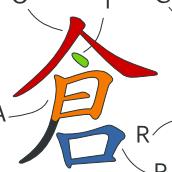Two-unit characters are characters that can be divided into two units based on the shape of a character. This can be a division based on left-to-right, top-to-bottom, or outer-to-inner. If you are familiar with radicals then the concept is not so alien. For left-to-right often a spacing, or lack of connecting from the left side of the character to the right side of the character, is where the the character is divided up into two units. For top-to-bottom it can be more tricky, but again if you think back to character radicals it is not a leap. For outer to inner, there is an outer shell unit that encompasses the inner unit.
Once the character is divided up into two units, the following rules apply for determining the Cangjie input code:
1) The first unit may only have up to two Cangjie symbols input. If there are more than two symbols in the unit, then only the first and last Cangjie symbols are input on the keyboard.
2) The second unit may have up to three Cangjie symbols input. Again, if there are more than three, some skipping is involved. In this case, the first, second and last Cangjie symbols are input on the keyboard.
This may seem a bit abstruse, so let's look at some examples. Unfortunately I am on my android device right now and I don't yet have a very good Cangjie input method tool, so I'm still looking for a better way to bring up just the Cangjie symbol to show how things are built up. As such, to make sense of the following I suppose you need some familiarity with Cangjie symbols. I will try to update this post later if I can figure it out.
1) 風 / 风
A quick visual examination yields a clear outer-to-inner relationship in both the traditional form and simplified form of the character. The outer unit is 几, which can be made up using Cangjie codes that look like 厂乙 (note these are radicals on don't reflect the exact Cangjie symbols, but I wanted to provide something to help see how the unit is broken down to Cangejie symbols. To build the unit, the input code is HN for the outer unit. The inner unit looks like 虫 with a "hat" on top. This unit requires four symbols, so we have to skip the third, with the Cangjie code being HLI. The resulting Cangjie code for the entire character is HNHLI.
For the simplified character it is similar. The first unit is HN still, but the innter unit is simplified. It turns out that this unit actually represents a Cangjie symbol, so the Cangjie code for this unit is just K. Putting it all together, the resulting code for the entire character is HNK.
2) 鍾 / 锺
Upon visual inspect, this character is a left-to-right two-unit character. The first unit is 金 or钅, and the second unit is 重. Well, 金 is actually a Cangjie symbol, so for both the traditional and simplified forms, the input code for the first unit is C, and that completes the unit. The second unit, however, has four Cangjie symbols in it, so we have to skip the third since we are only allowed up to three symbols. The unit is made of a "hat" stroke on the top, 十 just below it, then skipping 田 because it is the third symbol, and finally 土. This turns out to HJG, and thus the entire code for this character is CHJG.
3) 規 / 规
Again, this is a left-to-right two-unit character. Based on the Cangjie symbols, the left side is built with the codes QO. For the right side, the code comes out to BUU for the tradtional. For the simplified, it is BHU. Again, I wish I could input just these Cangjie symbols for reference, but this one is proving challenging for my Android input method. The final code is QOBUU for the tradtional version,a nd QOBHU for the simplified version.
Well, that is it for today, looking back at this post I am not even sure if it is useful. But oh well, this is kind of my journal too. When I am back on a real computer I will see what I can do.


